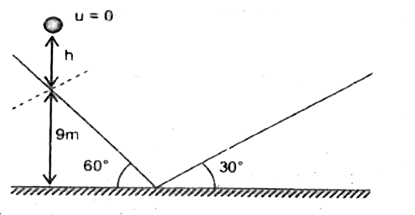Text Solution
Verified by Experts
The correct Answer is:
|
Topper's Solved these Questions
COLLISION
FIITJEE|Exercise ASSIGNMENT PROBLEMS (OBJECTIVE) Level - I|45 VideosView PlaylistCOLLISION
FIITJEE|Exercise ASSIGNMENT PROBLEMS (OBJECTIVE) Level - I (ASSERTION REASONING TYPE)|2 VideosView PlaylistCOLLISION
FIITJEE|Exercise ASSIGNMENT PROBLEMS (SUBJECTIVE) Level - I (Numerical)|8 VideosView PlaylistAC CIRCUITS
FIITJEE|Exercise ASSERTION REASONING TYPE|1 VideosView PlaylistCURRENT ELECTRICITY
FIITJEE|Exercise Comprehension -4|3 VideosView Playlist
Similar Questions
Explore conceptually related problems
Knowledge Check
A
B
C
D
Submit
A
B
C
D
Submit
A
B
C
D
Submit
Similar Questions
Explore conceptually related problems
FIITJEE-COLLISION -ASSIGNMENT PROBLEMS (SUBJECTIVE) Level - II
- A ball is dropped from a height h on a inclined plane, ball collides e...
Text Solution
|
Playing Now - A simple pendulum of length l and mass m is hinged at point A in a ver...
Text Solution
|
Play - A block of mass M, with a semicircular track of radius R rest on a hor...
Text Solution
|
Play - Find the centre of mass of a thin, uniform disc of radius R from which...
02:55
|
Play - A block A of mass m is lying on a rough horizontal surface. Another bl...
07:07
|
Play - A particle of mass 0.01 kg moving horizontally with velocity 20 m/s st...
Text Solution
|
Play - Two identical blocks A and B of mass M each are kept on each other on ...
Text Solution
|
Play - A ball of mass m is projected vertically up from a smooth horizontal f...
04:00
|
Play - A wedge of mass M and angle alpha rests on a smooth horizontal plane. ...
07:47
|
Play - Two identical beads each of mass 'm' can slide freely on a ring of mas...
04:33
|
Play - A block of mass 200 g is suspended by a vertical spring. The spring is...
Text Solution
|
Play - A body of mass M (figure) with a small disc of mass m placed on it res...
09:00
|
Play - A particle of mass m moves with velocity u(1)=20m//s towards a wall th...
03:03
|
Play - A block of mass M with a semi circular track of radius R, rests on a h...
Text Solution
|
Play - A U shaped rod is kept stationary with plane vertical. A washer of mas...
Text Solution
|
Play - Find the loss of KE of the two particles of mass m(1)=3 kg & m(2)=6 kg...
05:01
|
Play - A uniform chain of mass m and length l hangs on a thread and touches t...
03:48
|
Play
